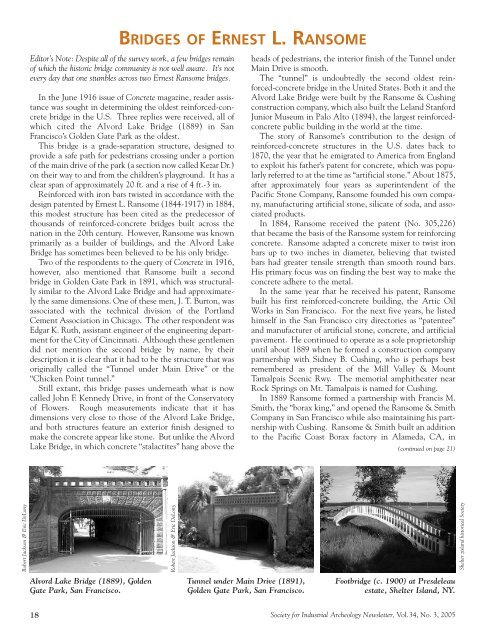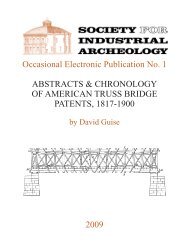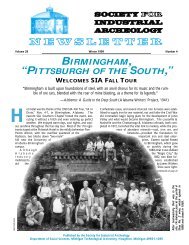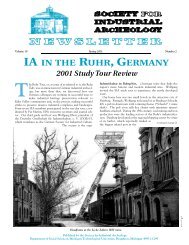SIAN - Society for Industrial Archeology
SIAN - Society for Industrial Archeology
SIAN - Society for Industrial Archeology
Create successful ePaper yourself
Turn your PDF publications into a flip-book with our unique Google optimized e-Paper software.
Robert Jackson & Eric DeLony<br />
Editor’s Note: Despite all of the survey work, a few bridges remain<br />
of which the historic bridge community is not well aware. It’s not<br />
every day that one stumbles across two Ernest Ransome bridges.<br />
In the June 1916 issue of Concrete magazine, reader assistance<br />
was sought in determining the oldest rein<strong>for</strong>ced-concrete<br />
bridge in the U.S. Three replies were received, all of<br />
which cited the Alvord Lake Bridge (1889) in San<br />
Francisco’s Golden Gate Park as the oldest.<br />
This bridge is a grade-separation structure, designed to<br />
provide a safe path <strong>for</strong> pedestrians crossing under a portion<br />
of the main drive of the park (a section now called Kezar Dr.)<br />
on their way to and from the children’s playground. It has a<br />
clear span of approximately 20 ft. and a rise of 4 ft.-3 in.<br />
Rein<strong>for</strong>ced with iron bars twisted in accordance with the<br />
design patented by Ernest L. Ransome (1844-1917) in 1884,<br />
this modest structure has been cited as the predecessor of<br />
thousands of rein<strong>for</strong>ced-concrete bridges built across the<br />
nation in the 20th century. However, Ransome was known<br />
primarily as a builder of buildings, and the Alvord Lake<br />
Bridge has sometimes been believed to be his only bridge.<br />
Two of the respondents to the query of Concrete in 1916,<br />
however, also mentioned that Ransome built a second<br />
bridge in Golden Gate Park in 1891, which was structurally<br />
similar to the Alvord Lake Bridge and had approximately<br />
the same dimensions. One of these men, J. T. Burton, was<br />
associated with the technical division of the Portland<br />
Cement Association in Chicago. The other respondent was<br />
Edgar K. Ruth, assistant engineer of the engineering department<br />
<strong>for</strong> the City of Cincinnati. Although these gentlemen<br />
did not mention the second bridge by name, by their<br />
description it is clear that it had to be the structure that was<br />
originally called the “Tunnel under Main Drive” or the<br />
“Chicken Point tunnel.”<br />
Still extant, this bridge passes underneath what is now<br />
called John F. Kennedy Drive, in front of the Conservatory<br />
of Flowers. Rough measurements indicate that it has<br />
dimensions very close to those of the Alvord Lake Bridge,<br />
and both structures feature an exterior finish designed to<br />
make the concrete appear like stone. But unlike the Alvord<br />
Lake Bridge, in which concrete “stalactites” hang above the<br />
Alvord Lake Bridge (1889), Golden<br />
Gate Park, San Francisco.<br />
BRIDGES OF ERNEST L. RANSOME<br />
Robert Jackson & Eric DeLony<br />
Tunnel under Main Drive (1891),<br />
Golden Gate Park, San Francisco.<br />
heads of pedestrians, the interior finish of the Tunnel under<br />
Main Drive is smooth.<br />
The “tunnel” is undoubtedly the second oldest rein<strong>for</strong>ced-concrete<br />
bridge in the United States. Both it and the<br />
Alvord Lake Bridge were built by the Ransome & Cushing<br />
construction company, which also built the Leland Stan<strong>for</strong>d<br />
Junior Museum in Palo Alto (1894), the largest rein<strong>for</strong>cedconcrete<br />
public building in the world at the time.<br />
The story of Ransome’s contribution to the design of<br />
rein<strong>for</strong>ced-concrete structures in the U.S. dates back to<br />
1870, the year that he emigrated to America from England<br />
to exploit his father’s patent <strong>for</strong> concrete, which was popularly<br />
referred to at the time as “artificial stone.” About 1875,<br />
after approximately four years as superintendent of the<br />
Pacific Stone Company, Ransome founded his own company,<br />
manufacturing artificial stone, silicate of soda, and associated<br />
products.<br />
In 1884, Ransome received the patent (No. 305,226)<br />
that became the basis of the Ransome system <strong>for</strong> rein<strong>for</strong>cing<br />
concrete. Ransome adapted a concrete mixer to twist iron<br />
bars up to two inches in diameter, believing that twisted<br />
bars had greater tensile strength than smooth round bars.<br />
His primary focus was on finding the best way to make the<br />
concrete adhere to the metal.<br />
In the same year that he received his patent, Ransome<br />
built his first rein<strong>for</strong>ced-concrete building, the Artic Oil<br />
Works in San Francisco. For the next five years, he listed<br />
himself in the San Francisco city directories as “patentee”<br />
and manufacturer of artificial stone, concrete, and artificial<br />
pavement. He continued to operate as a sole proprietorship<br />
until about 1889 when he <strong>for</strong>med a construction company<br />
partnership with Sidney B. Cushing, who is perhaps best<br />
remembered as president of the Mill Valley & Mount<br />
Tamalpais Scenic Rwy. The memorial amphitheater near<br />
Rock Springs on Mt. Tamalpais is named <strong>for</strong> Cushing.<br />
In 1889 Ransome <strong>for</strong>med a partnership with Francis M.<br />
Smith, the “borax king,” and opened the Ransome & Smith<br />
Company in San Francisco while also maintaining his partnership<br />
with Cushing. Ransome & Smith built an addition<br />
to the Pacific Coast Borax factory in Alameda, CA, in<br />
(continued on page 21)<br />
Footbridge (c. 1900) at Presdeleau<br />
estate, Shelter Island, NY.<br />
18 <strong>Society</strong> <strong>for</strong> <strong>Industrial</strong> <strong>Archeology</strong> Newsletter, Vol.34, No. 3, 2005<br />
Shelter zisland historical <strong>Society</strong>






